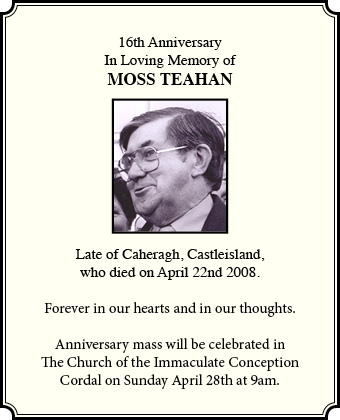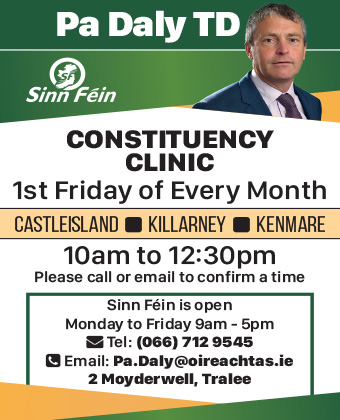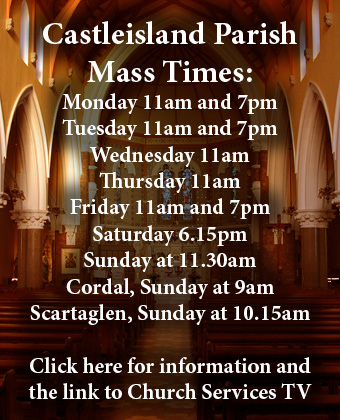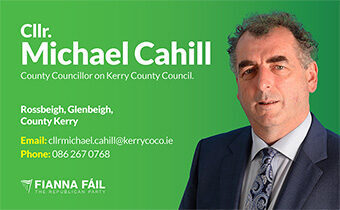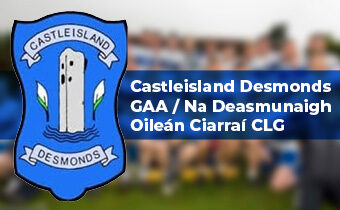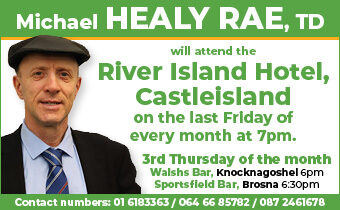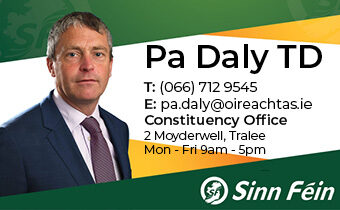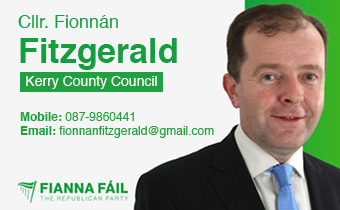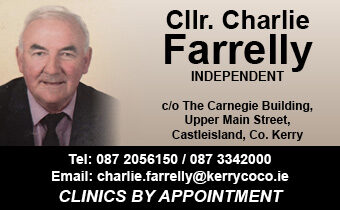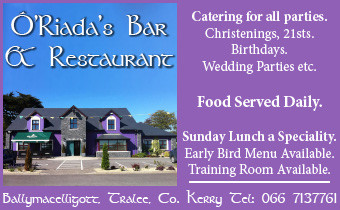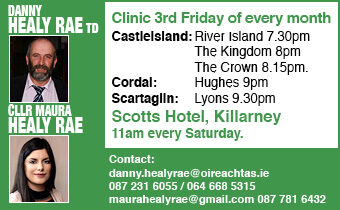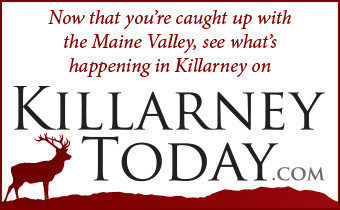
After being introduced by Castleisland Parish Committee Chairman, Jack Shanahan, the local choir opened the evening with the Mediaeval Latin hymn, Gaudete.
Monsignor Dan O’Riordan later remarked that it was indeed appropriate as the occasion was one of rejoicing for the launch of the 2015 Castleisland Parish Magazine at the River Island Hotel.
‘Fr. Dan’ pointed out that the publication was a great community effort and a Castleisland job from concept to hard copy. He thanked all involved from the editorial committee, the contributors, designer and printers.
The special guest on the night was Fr. Pat Ahern. And, in launching the magazine, he placed its being squarely on the shoulders of his colleague of the cloth, Fr. Dan. He wondered aloud – to the 100 plus gathering – if he wasn’t part of the parish and not in the driving seat here, would the magazine ever be heard of – let alone celebrating its third, annual coming.
Accident or design, but the Mediaeval theme continued within the covers of the just launched magazine. Local collector and historian, Timothy Murphy traced the origins of the town and its churches through the Norman invasion to the present day.
In fact, Timothy’s contribution to the publication in hand and to historical debate in the Castleisland area in general, merited him being mentioned in the same breath as the late Fr. Kieran O’Shea.
Fr. O’Shea’s landmark 1991 book ‘Castleisland Church and People’ opened a chapter of historical awareness in the area that’s still as relevant today as it was when it was first published.
Timothy took on the task of going back on the establishment of the churches in the three areas of the parish concerned: Castleisland, Cordal and Scartaglin and he credits Fr. Kieran O’Shea’s vast body of research in the compilation of these articles.
Church of Saints Stephen and John, Castleisland

While the area was settled well beforehand, Castleisland town owes its origin to the Norman conquest of County Kerry. In the early 1200’s, Geoffrey de Marisco, the then chief governor of Ireland, built a series of castles by the River Maine. One of these, built in 1226, was surrounded by a moat and it is this that is thought to give the town its name.
One of the first churches in the Castleisland area was dedicated to St. Stephen, a saint dear to the Normans.
In Mediaeval times there were several small churches recorded in the Castleisland area. They were to be found at Kilmurry, Killananma, Cahernard (Kealgorm), Killbannivane and St Nicholas’ Church in the town itself.
With the fall of the last Earl of Desmond in 1583 these churches were confiscated and eventually fell into ruins. St. Nicholas’s was then used by the Established Church as a place of worship; Rev. Thomas Ewes was the first rector.
By 1640 it was badly neglected and was reported as being in need of serious repair and this situation had not improved by 1661.

We are not sure where the catholic population went, at the height of the Penal Laws, for the sacraments and to assist at Mass. Indeed, there is no mention of any church-building in Castleisland in the early part of the 18th century.
It is very likely that Mass was celebrated in some cabin or glen. Near Scartaglin there is a place called Gleann an Aifrinn which would indicate the presence of a Mass rock. Tradition also tells us that there was another Mass rock in Knockatee in Cordal.
In the 1770’s, with the relaxation of the Penal Laws, Catholics could practice their religion more openly again. Thatched churches were built by Fr. Darby O’Shanahan in Castleisland and Scartaglin around 1775. Fr. Darby’s successor was Fr. Maurice Fitzgerald. He in turn was succeeded by Fr. Jeremiah O’Leary.
Rev. Jeremiah ‘Darby’ Shanahan
Born about 1745, probably in Abbeydorney. He was ordained in Paris 1770 and was appointed Parish Priest about 1774.
It is thought that he built the old thatched church in Old Chapel Lane. He died in 1781 and is buried in the Shanahan tomb in the old graveyard attached to St. Stephen’s Church.
Rev. Maurice Fitzgerald
Born 1746. He was ordained 1774 and appointed Parish Priest in 1781
At first he celebrated Mass in the old thatched church in Old Chapel Lane. It was he that built the old Church that faced the now Convent Street.
He died in 1830, aged 84 years. He was P.P. in Castleisland for 49 years.

In October 1846 the Presentation Sisters arrived in Castleisland. In June 1847 they were able to take possession of their convent. The sisters taught the children of the parish in the church. At the time it was a cold, damp building with flagged floors.
The bad conditions soon took their toll and one of the sisters died from consumption in April 1849, aged only 27. The sisters erected a new school which was opened in 1850. The original site is now the Convent Chapel and dining room.
In 1866 Bishop Daniel McCarthy appointed Fr. John O’Connell as parish priest of Castleisland. When Bishop McCarthy visited Castleisland in September 1878 he found the parish church in a dilapidated condition with ‘jagged and irregular and leaky roof, the decayed timbers, the crumbling ceiling’.
He urged parishioners to support their parish priest, Archdeacon John O’Connell in his efforts to build a new church in the town. As a result of this, a meeting of the people of Castleisland was held in the old church later that year.
Bishop McCarthy attended and preached to the people, encouraging them to start work on the new building. It was revealed that the building would cost at least £6,000.00, but that there was over £1,000.00 in the parish funds, the proceeds of church gate collections.
Fr. Arthur Murphy had gone on a fund-raising campaign to America, Australia and New Zealand and had already forwarded a cheque for £1,380.00. To make up the balance, a general parish fund was decided on and a building committee was formed.
The next step was to employ an architect. Seven were invited to send in designs for the church. The design of D. J. Coakley, Cork was accepted. In October 1880 the Kerry Sentinel carried an advertisement, seeking tenders for building the new parish church. The contract was given to Butler Brothers, Killarney.
Work began in March 1881 and the foundation stone was laid by Bishop McCarthy on 24th May. There was a great gathering of clergy for the occasion and, although it was a market-day in the town, people were pouring in and out of the grounds all day.
 Times were not so different. It appears that there was not enough money allocated to the project. There was a serious hold-up in 1882 when the Butler Brothers went bankrupt and the search went out for a new contractor.
Times were not so different. It appears that there was not enough money allocated to the project. There was a serious hold-up in 1882 when the Butler Brothers went bankrupt and the search went out for a new contractor.
This time the building committee turned to John Sisk and Co. from Cork. An agreement was drawn-up on 27th November 1882, the plans were amended at an additional cost of £4,400.00.
On the 11th December 1883 the parishioners gathered in the yet unfinished church for an important ceremony. On that day he remains of the priests buried in the old church were reinterred in the new one.
On the 5th October 1884, in the presence of Bishop Higgins, the church of Saints Stephen and John was blessed an opened.
In the original plan, provision had been made for a tower and spire. It was to be a very ornate structure on the lines of early French Gothic style but as the cost was proving prohibitive a more modest design was decided on.
The work was carried out by Patrick Murphy, Tralee. He began in the spring of 1910 and had it finished by December of the same year.
The height of the spire from the ground is given as one hundred and seventy feet. On top of the spire was fixed a cross of Irish manufacture. The church has not stood still. Over the last century many changes and improvements have been made. The journey continues.
Church of The Immaculate Conception, Cordal

With the relaxation of most of the Penal Laws in the latter half of the 18th century, catholic churches were again being built. In the Castleisland parish, the church that preceded the present buildings at Scartaglin and Castleisland date from this period but we are not sure of the exact date for the old church at Ardnagragh.
The earliest date that we have for the old chapel at Ardnagragh is 1824, when it was also used as a school. It was located a short distance to the south of Killananma graveyard and is shown in the 1845 Ordnance Survey map. The site of the church is now a haggard owned by Seán Walsh.
It is stated in Lewis’s Topographical Dictionary, published 1837, that ‘The chapel, a plain but commodious building is situated at Cordal, near Ardnagragh’: it had deteriorated very much by 1866.

It was described in the Tralee Chronicle of that year, as ‘a dark. squat, solid lump of a thick thatched hovel, of no capacious dimension which presents the apology for the chapel of that parish’.
That year Archdeacon John O’Connell was appointed parish priest of Castleisland and he decided to replace the old church at Ardnagragh.
A site was acquired and Archdeacon O’Connell drew up his own plans for the building. He built the church for around £800 and it was dedicated to the Blessed Virgin. Bishop David Moriarty opened it on the 6th October 1872 and confirmed 80 children on that occasion. Four years later, on the 10th December 1876, Bishop Moriarty was back again, this time to consecrate the new altar, which replaced a temporary one.
In 1915 Margaret S. Fahey, a Cordal native who emigrated to the U.S.A., donated the beautiful white marble sculpture to the church in memory of her parents, Richard and Bridget Horan.
It is a faithful replica of the original by Michaelangelo in St. Peter’s Basilica in Rome. The church has twelve beautiful stained glass windows, funded by families from the parish. Including Cordal native Archbishop Redmond Prendiville (Archbishop of Perth)
In 1935 Archdeacon Casey decided to enlarge the church. Work began in 1935. Daniel O’Connor was the contractor.
Many local people gave a few days voluntary labour while some farmers drew gravel for the building. When the work was completed in 1936, the seating capacity was doubled.
In 1960 Canon David O’Connor renovated the church and installed central heating at the cost of about £6,000.
On 8th December that same year Bishop Denis Moynihan blessed and rededicated the church to the Immaculate Conception of Our Lady.
In 1974 the original altar slab was replaced with the new one, in memory of William Eager and his parents.
Church of Our Lady of Lourdes, Scartaglin

A document in the diocesan archives in Killarney states that the old church in Scartaglin was built about 1775 and that it was dedicated to St. Michael. It was located on the outskirts of the village, on the left-hand side of the road when travelling from Castleisland. The site of the church is now the location of Riordan’s garage.
It is shown on the 1845 Ordnance Survey map. The priest responsible for its building was Fr. Darby O’Shanahan. In 1824 a school was held in this church. Its roof was still thatched in 1890.
By 1928 the walls were crumbling and the roof was beyond repair. Archdeacon John Casey P.P. Castleisland, seeing this, decided to build a new church.
Work on the building began in 1928. Patrick O’Flynn, Millstreet, was the contractor, D.M. O’Connor, Cork was the architect and John Murphy, Barraduff was the foreman.

The capacity of the church was estimated at 1,200 and the cost just over £8,000. The high altar was of Italian marble with a panel of Connemara marble.
When the church was opened on the 14th July 1930 by Bishop O’Brien and it was dedicated to Our Lady of Lourdes, only a small debt remained to be paid off . Due to the generosity of the people, the many bazaars held and G.A.A. tournaments played, the proceeds all went towards the church fund to pay-off the debt.
Articles by Timothy Murphy 2015. Based on research by the late Fr. Kieran O’Shea.
Copies of the 2015 Castleisland Parish Magazine are available in the three parish churches or from Castleisland Parish Office at 066 71 41241.




